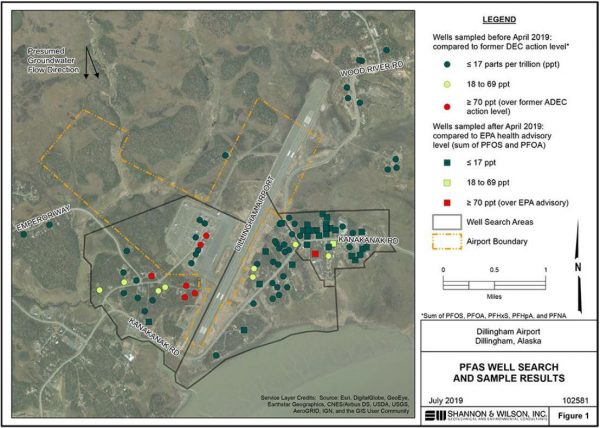
A year after PFAS was first detected in Dillingham wells, the state and a consulting firm are taking steps to address the situation.
A plan now in the works would address PFAS contamination in Dillingham. Shannon & Wilson, Inc., an engineering consultant based in Anchorage, and the Alaska Department of Transportation & Public Facilities are drafting a feasibility plan to tackle the issue, after several months of testing wells around the Dillingham airport.
Shannon & Wilson was in town at the end of November for its third quarterly PFAS sampling. The firm tested five of six contaminated wells south of the Dillingham airport. (The sixth well was sampled when it was in use during the summer.) Testing started in February, and the latest round, completed in July, showed that no further sampling was required to begin a feasibility study.
Sammy Cummings, a PFAS coordinator for the DOT & PF, said Shannon & Wilson is now looking at ways to address the affected wells.
“We have a strong understanding of those who are impacted. And now we can start working on the next phase of implementing a long-term solution,” she said. “So this feasibility study is going to give us different options and then we’ll be able to work with homeowners and businesses on what the best solution should be.”
PFAS, or per- and polyfluoroalkyl substances, are a group of man-made chemicals found in many materials, including firefighting foam. The contamination in Dillingham wells is due to runoff from the foam used during annual airport safety drills since the 1970s. According to the Alaska Department of Health & Social Services, high exposure to the chemicals over a long period of time could harm a person’s health.
Some solutions could include designing a filtration system or implementing a public water storage. Cummings said they won’t know until the study is complete.
“What would happen after the feasibility study, we’d then review the report, start procuring, contracting or going out to bid in order to start the construction of whatever the long term solution might be,” she said.
This comes a year after high levels of PFAS contamination were discovered in the well of the Holy Rosary Catholic Church. It was a popular drinking well in Dillingham, with a PFAS count measuring at more than three times the state Department of Environmental Conservation’s health advisory level.
The DOT & PF estimates that the report will be completed this spring. The goal is to start work during the 2020 construction season. Results from the latest visit to Dillingham will be available at the end of December.
Contact the author at tyler@kdlg.org or 907-842-2200




